This Baklava Cheesecake recipe makes a beautiful centerpiece to any holiday dessert table. Flaky phyllo envelops a luscious orange-scented ricotta cheesecake filling that is finished with honey and pistachios!
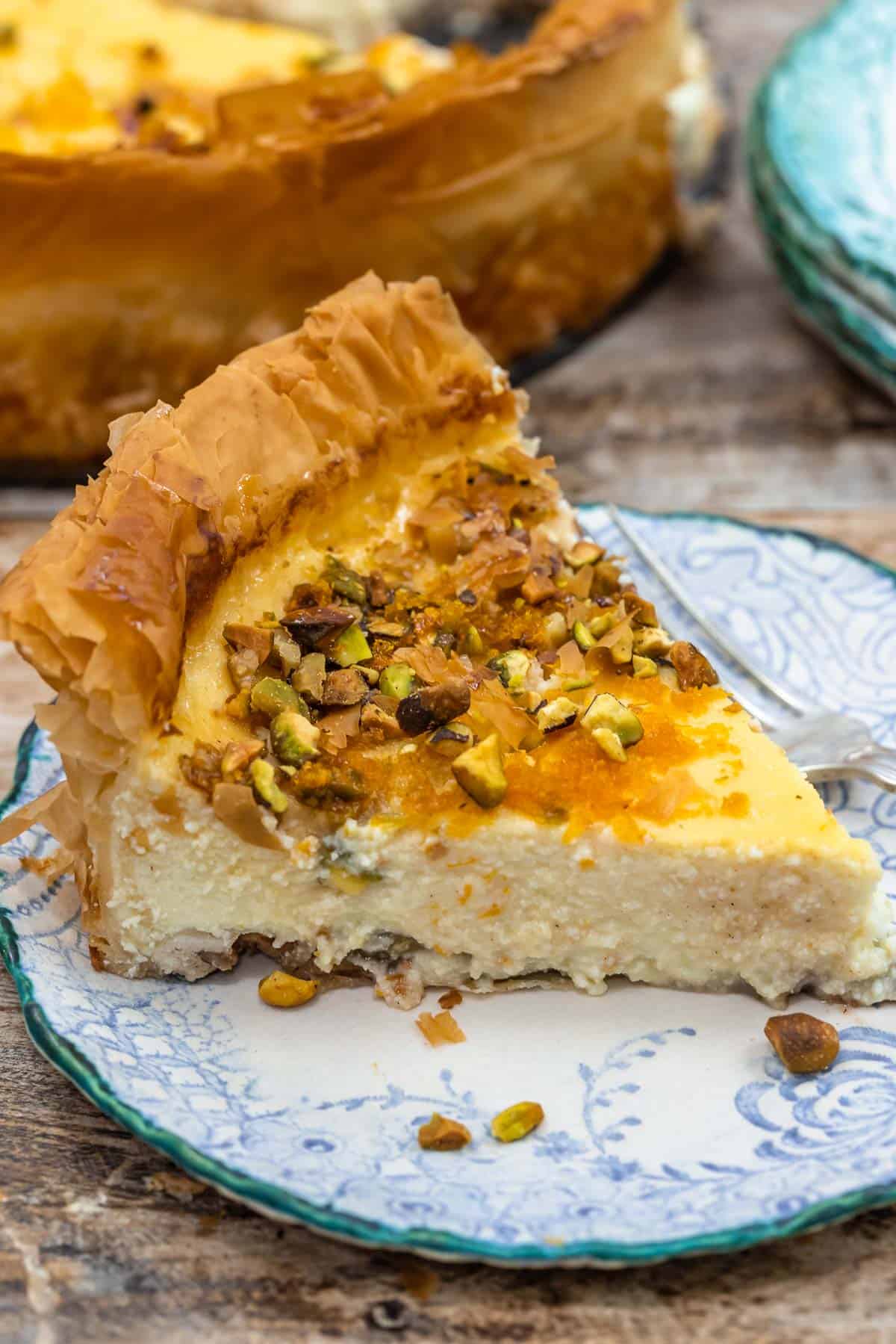
Just like with my baklava sundae, or pumpkin pie this easy cheesecake recipe is a combination of two desserts I absolutely love: baklava and ricotta cheesecake. Not only does it taste divine, but the crinkly phyllo crust and bright pistachio garnish make for a real show-stopper.
When you grow up eating baklava at every family gathering like I did, you have some strong opinions about what makes the best tasting baklava — honey-soaked phyllo pastry and cinnamon-scented nuts make for a heavenly dessert. When I combined what I love about baklava with my favorite creamy, orange zest-infused ricotta cheesecake filling, this Baklava Cheesecake recipe was born!
If you’re nervous about making cheesecake, don’t worry! The foundation of this recipe is my 5-ingredient Italian Lemon Ricotta Cheesecake recipe with one minor change. I simply swapped lemon zest for orange zest in the cheesecake batter. (You just don’t mess with a great recipe that gives you an indulgent yet airy cheesecake.)
Cheesecake does best when it sits in the fridge for 24 hours before serving, which makes it a perfect make ahead dessert. You’ll probably have extra phyllo dough leftover in your package, which is always exciting to me because I use it to make my favorite Sigara Boregi (Turkish feta cheese rolls).
Table of Contents

How to Make Baklava Cheesecake
- Prepare the ingredients for the crust: You’ll need a 10-inch springform pan, 10 sheets of thawed phyllo dough, extra-virgin olive oil and a pastry brush. In a small bowl, mix together ⅓ cup crushed walnuts, ⅓ cup crushed pistachios, 2 tablespoons sugar and 1 teaspoon ground cinnamon. Lightly brush the springform pan with olive oil and place it on a sheet pan.
- Prepare the crust: Lay 2 sheets of phyllo over the oiled springform pan and gently press into the bottom and sides of the pan, fitting the phyllo to the springform pan. Brush the phyllo with extra-virgin olive oil, including the part that overhangs the pan. Lay another 3 sheets of phyllo at a 90 degree angle to the first two, so that the pan is now completely covered with phyllo. There should be phyllo slack hanging over all sides of the pan at this point. Brush the new layers with extra-virgin olive oil.
- Sprinkle the nut and sugar mixture over the bottom of the pan in an even layer. Lay 2 sheets of phyllo over the nut and sugar mixture, brush with olive oil. Lay the remaining 3 sheets of phyllo at a 90 degree angle, brush with olive oil. If the overlay of the phyllo is too long, simply trim it with a pair of kitchen shears. Phew! Hard part’s over, you’re done with the crust!
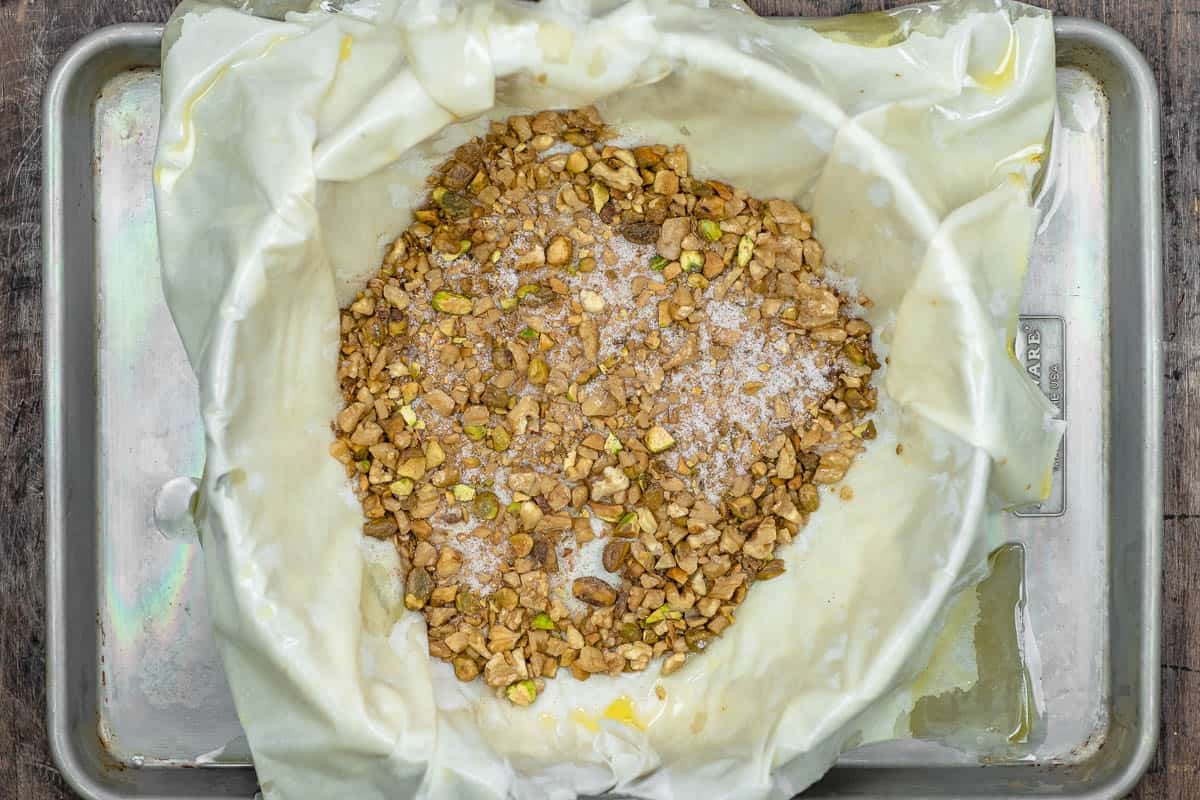
- Prepare the cheesecake filling: In the bowl of a stand mixer fitted with the paddle attachment, combine ricotta cheese, eggs, sugar, vanilla extract and the zest of 1 orange. Mix on low speed, then increase to medium low and beat for 10 minutes, or until light and fluffy. No stand mixer? No problem! Use a hand mixer and beat on low speed for 10 minutes, or get your arm workout for the day by using a wooden spoon, mixing vigorously until very fluffy.
- Assemble and bake your baklava cheesecake: Preheat oven to 350°F. Pour batter into prepared phyllo crust. Bake in preheated oven until the filling is mostly firm and the phyllo crust is a beautiful golden brown, about 1 ½ hours. Don’t worry if the batter jiggles slightly in the middle, it will solidify as it cools. Keep an eye on the crust in the last half hour of baking: if it looks like it’s getting too brown, turn the heat down to 325°F.
- Cool and chill: Allow the cheesecake to cool completely at room temperature, anywhere from 1 to 2 hours. Place in the fridge for at least 6 hours or overnight.
- Remove the cheesecake from the springform pan: When ready to serve, remove the cheesecake from the fridge and gently break off any pieces of phyllo dough that are stuck to the sides of the pan and may hinder its removal. (You can crumble those pieces and add them to the top to add to the garnish, or just have a little snack!) Carefully unlock the side of the springform pan and remove. Transfer to a platter.
- Garnish and serve! Gently warm ¼ cup to ⅓ cup honey either in the microwave or on the stovetop. Drizzle honey over the top of the cheesecake (don’t skip the crispy phyllo crust!) and garnish with more chopped walnuts and pistachios. Finish with a little orange zest and enjoy!
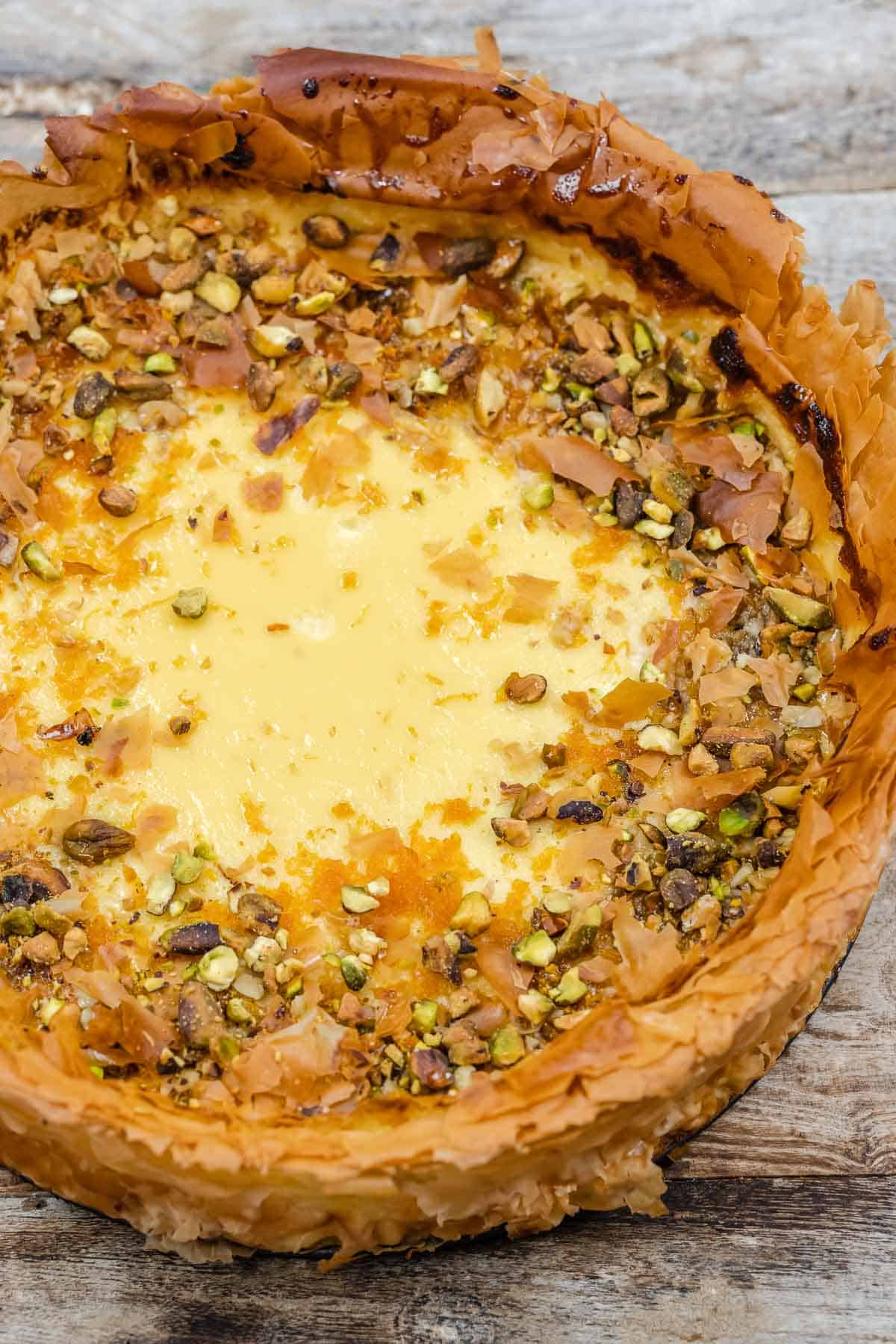
Tips for Making Baklava Cheesecake
What’s the secret to making the perfect cheesecake? As I said earlier, lots of people are intimidated by cheesecake, but my ricotta cheesecake filling is simple and delicious — no complicated steps or water baths required! That said, a few easy pointers will make this baklava cheesecake recipe a new favorite.
- Quality ingredients: Splurge on the nicest ricotta you can find, seek out farm-fresh eggs and use real vanilla extract, not the imitation kind. I’m partial the Greek honey from our shop.
- No watery cheesecakes, please: Drain the ricotta of excess liquid before mixing it with the other filling ingredients. For best results, line a strainer with cheesecloth add the ricotta and press down gently to expel any excess liquid. If your ricotta seems super watery, set the strainer over a bowl and let it drain overnight in the fridge.
- Temperature matters: For best results, bring your (strained) ricotta and eggs to room temperature before making the cheesecake filling. Cold ingredients can result in a lumpy batter! For a smooth creamy cheesecake set the ricotta and eggs on the counter while you prepare the crust.
- Slow and low: Mix the batter low and slow to gradually incorporate air into the ingredients. When done in this manner the batter will be smooth, light and fluffy. Mix too fast and you risk a tough, chewy filling, that could crack. No thank you!
- No peeking: Once the cheesecake is in the oven, you may be tempted to take a peek to see how things are going. Don’t do it! Opening the door will lower the temperature inside the oven, resulting in an uneven cheesecake that doesn’t rise properly. Give your cheesecake at least an hour in the oven before checking for doneness.
- Cool completely: The cheesecake will continue to cook when removed from the oven. Let it cool on the countertop for 1 to 2 hours before transferring it to the fridge. This is an important part of the setting process! Cooling it further in the fridge (ideally overnight) creates a completely set cheesecake.
What does Baklava Cheesecake Taste Like?
Crunchy phyllo dough, warm honey and the earthy sweetness of nuts meet a cool, creamy, orange-flecked ricotta custard — are you drooling yet?
My baklava cheesecake has just enough sweetness to satisfy your dessert cravings. Enjoy it with an after-dinner Carajillo, a spiked coffee drink.

What is Phyllo Dough?
Phyllo dough is very thin sheets of unleavened pastry, characterized by its brittle, flaky texture. You may know it from desserts like baklava or savory dishes like spanakopita. Traditionally made with flour, water and a small amount of oil or butter, most phyllo dough today is vegan.
How to Use Phyllo
Phyllo can be a little finicky to work with but if you defrost it properly, brush each layer with oil to prevent it from breaking, and cover what you’re not using it’s pretty smooth sailing from there.
- Defrost first: It’s important to thoroughly defrost frozen phyllo dough before using. For best results, place the phyllo dough in the fridge for at least 8 hours or overnight. If it still feels slightly frozen, allow it to sit at room temperature for an hour before using.
- Phyllo + fat = a match made in heaven: Because phyllo dough is so paper-thin, it can get brittle very quickly. Brushing phyllo with fat (typically olive oil or melted butter) keeps it supple and helps it bake up golden brown and crispy.
- Cover it up! Layering phyllo dough for the crust of my baklava cheesecake can take some time, so it’s important to keep the dough covered as you work with it. Phyllo dough, when left exposed to the air for too long, will become dry and can shatter into one million frustrating little pieces. A clean, slightly damp kitchen towel works best to keep the phyllo dough pliable while you’re assembling the crust.

Baklava Cheesecake: The Perfect Make-Ahead Dessert
Cheesecake, whether it’s Greek Yogurt Cheesecake, this Baklava Cheesecake, or classic NY-style cheesecake requires a long chill time in the refrigerator to fully set. Make it the day before your next dinner party and check dessert off your to-do list! Any leftovers will keep for up to 4 days.
Can I Freeze Baklava Cheesecake?
Yes you can, but the phyllo crust will not be as crispy as it was when freshly baked. It will, however, still be delicious!
- Portioning the cheesecake into slices first.
- Wrap each slice tightly in plastic and then cover with a layer of foil.
- To defrost, place the slice in the fridge for 5-6 hours.
- Frozen baklava cheesecake will last up to 2 months in the freezer.
More Dessert Recipes!
Appetizer and Mezze
Phyllo-Wrapped Baked Feta with Honey
Appetizer and Mezze
Strawberry Tart with Fillo Crust
Turkish
How to Make Baklava
Browse all Mediterranean recipes.
Visit Our Shop.
The Mediterranean Dish Cookbook
The Mediterranean Dish Cookbook: 120 Bold and Healthy Recipes You’ll Make on Repeat. In her book, Suzy brings cross-culturally inspired dishes from throughout the Mediterranean to you, using easy-to-find ingredients and easy-to-follow, to make your meals more vibrant, delicious, and yes — even a little healthier, too!
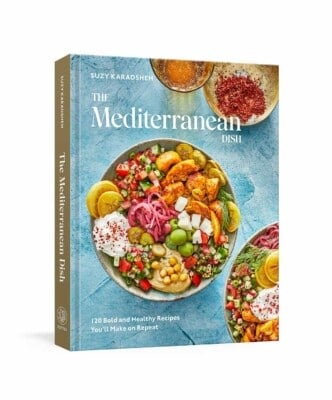
Baklava Cheesecake

Ingredients
For the phyllo crust
- Extra virgin olive oil
- 1/3 cup walnuts, chopped
- 1/3 cup pistachios, chopped
- 2 tablespoons sugar
- 1 teaspoon ground cinnamon
- 10 sheets phyllo dough, thawed
For the cheesecake batter
- 3 pounds whole milk ricotta cheese, strained and room temperature
- 8 large eggs, room temperature
- 1 ¼ cup sugar
- 1 teaspoon vanilla extract
- Zest of 2 large oranges, divided
For garnish
- ¼ to ⅓ cup honey, warmed
- More chopped walnuts and pistachios
Instructions
- Heat the oven to 350°F and position a rack in the middle.
- Prepare a 10-inch springform cake pan and brush the sides and bottom with the olive oil. Place the pan on the center of a large sheetpan.
- Make the nut mixture: In a small bowl, mix together the nuts, sugar, and cinnamon. Set aside for now.
- Assemble the phyllo crust: Lay two sheets of phyllo in the oiled springform pan and press gently onto the bottom and sides. Brush the phyllo with extra virgin olive oil, including any parts hanging over the pan. Lay another 3 sheets of phyllo on top so they overlap, rotating the pan so that the phyllo will cover it on all sides (there should be phyllo slack hanging over on all sides of the pan). Brush with olive oil, then sprinkle the nut mixture over the phyllo to cover the bottom of the pan. Place the remaining phyllo sheets over the nut mixture, following the same pattern and making sure to brush each sheet of phyllo with extra virgin olive oil. (If the overlay of phyllo dough is too long, you can fold it over or cut it with a pair of kitchen scissors).
- Prepare the cheesecake batter: In the bowl of a standing mixer fitted with a paddle attachment, add the cheese, eggs, sugar, vanilla extract, and half the orange zest. Start the mixer on low for 1 to 2 minutes then increase the speed to medium-low (2 on the KitchenAid mixer) for 10 minutes. The mixture will look light and fluffy. If using a hand-mixer, keep the speed low. If using a wooden spoon, mix continuously until fluffy.
- Assemble and bake the baklava cheesecake: Pour the batter into the prepared pan with the phyllo.
- Bake: Place the cheesecake in a preheated oven for one to 1 ½ hours or until the batter has mostly firmed up and the top of the cake and phyllo crust has gained a nice golden brown color. The batter may still jiggle slightly in the middle, but it will firm up once cooled. (Do keep an eye on the phyllo crust, and if it is turning too brown too quickly, you may need to adjust the heat down to 325°F).
- Cool: Remove from the oven and place on a wire rack to cool for 1 to 2 hours. Transfer to the fridge for at least 6 hours or up to overnight.
- Release from the pan: Break off any extra phyllo crust hanging over the sides that could make it difficult to release the cake. (You can crumble the crust and add it on top to garnish). Release the lever on the side of the pan, remove the cake and transfer to a platter.
- Garnish and serve: Add chopped nuts and remaining orange zest to the top of the cake for garnish. Warm the honey and drizzle it all over the crust and top of the cake.
Video
Notes
- The crust takes a few sheets of phyllo dough, but don’t worry, you can absolutely use the rest to make my favorite Sigara Boregi (Turkish feta cheese rolls) or my Italian Style Breakfast Strata.
- This is a great dessert to make one night ahead so that you can allow the cheesecake to fully set and harden in the fridge.
- Visit Our Shop to browse quality Mediterranean ingredients including extra virgin olive oils and Greek honey used in this recipe. You can also browse our spice selection and more!


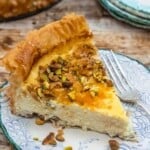
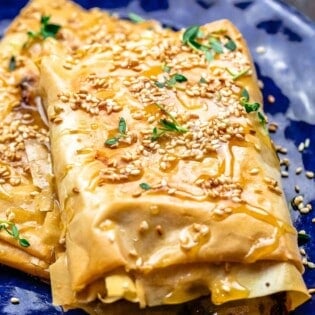
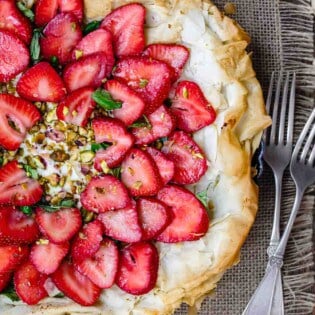


I’m impressed. Will try it out.